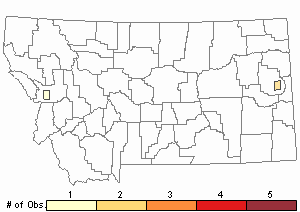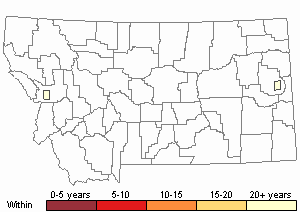View in other NatureServe Network Field Guides
NatureServe
Montana
Utah
Wyoming
Idaho
Wisconsin
British Columbia
South Carolina
Yukon
California
New York
Great Basin Grasshopper - Trimerotropis sparsa
General Description
The following is taken from Hebard (1928), Brooks (1958), Helfer (1971), Otte (1984), Vickery and Kevan (1985), Richman et al. (1993), and Brust et al. (2008). The general body color can vary from grayish, pale brown to reddish and finely speckled. The pronotum (thorax) has a distinct, bilobed central carina (ridge) which is lower on the posterior section (metazona). The forewings (tegmina) are grayish with scattered dark spots forming poorly defined bands. The hindwings are variable, being completely clear, tinted bluish, or very pale yellow; the band is barely indicated or absent. The outer face of the hind femur has small dark bands only on its dorsal surface. The inner surface is pale, with a black marking on the basal half and a black ring on the apical half. The hind tibia is pale yellow, sometimes mottled with brown.
Communicative behavior/Crepitation*
This species performs short, erratic flights producing loud crepitation just before alighting on the ground. No other communicative behavior signals have been reported (Brooks 1958, and Vickery and Kevan 1985).
*Crepitation is the sound produced by grasshoppers making a clicking or snapping noise with their wings when in flight, during courtship, territorial encounters or being disturbed.
Phenology
This species overwinters in the egg stage. Nymphs occur in spring, and adults are common in late July to September (Otte 1984, Vickery and Kevan 1985, and Brust et al. 2008).
Diagnostic Characteristics
The following comes from Hebard (1928), Brooks (1958), Helfer (1971), Otte (1984), Vickery and Kevan (1985), Richman et al. (1993), and Brust et al. (2008). The body length to tip of forewings is 24-32 mm for males, and 30-42 mm for females. Hindwing veins (3A, 4A and 5A) in the disk are usually dark and thickened.
The Great Basin Grasshopper can be confused with
Thomas’ Slender Grasshopper (
Trimerotropis gracilis). This species’ hind femur inner face has two pale bands (
T. gracilis has one) (Otte 1984).
Species Range
Montana Range
Range Descriptions

 Native
Native
Range Comments
This species occurs from southern British Columbia and Alberta, extending southward through western Washington, Oregon, and California, to northern Arizona, and New Mexico. From west to east, the Pacific states to the western Dakotas, panhandle of Nebraska, and western Colorado. In Montana, it has been reported for 7 counties. Reddish forms (as illustrated) are often encountered on the southside of the Pryor Mountains in Carbon County (Otte 1984, Vickery and Kevan 1985, and Scott 2010).
Observations in Montana Natural Heritage Program Database
Number of Observations: 3
(Click on the following maps and charts to see full sized version)
Map Help and Descriptions
Relative Density

Recency


 (Observations spanning multiple months or years are excluded from time charts)
(Observations spanning multiple months or years are excluded from time charts)
Habitat
The Great Basin Grasshopper, despite its broad western geographical range, is a relatively rare species, being found in small colonies which are considered to be isolated from one another by a considerable distance. It inhabits bare eroded areas, alkaline flats, eroded hillsides, and clay badlands. It is not considered a true desert species; but is only found in very arid areas. The species is rarely, if ever, found in sagebrush steppe habitats (Brooks 1958, Otte 1984, and Vickery and Kevan 1985).
Food Habits
Unknown.
Reproductive Characteristics
Unknown.
References
- Literature Cited AboveLegend:
 View Online Publication
View Online Publication Brooks, A.R. 1958. Acridoidea of Southern Alberta, Saskatchewan, and Manitoba (Orthoptera). The Canadian Entomologist (Supplement 9) 90:5-92.
Brooks, A.R. 1958. Acridoidea of Southern Alberta, Saskatchewan, and Manitoba (Orthoptera). The Canadian Entomologist (Supplement 9) 90:5-92. Brust, M.L, W.W. Hoback, and R.J. Wright. 2008. The Grasshoppers of Nebraska. Lincoln, NB: University of Nebraska Extension Service, APHIS.
Brust, M.L, W.W. Hoback, and R.J. Wright. 2008. The Grasshoppers of Nebraska. Lincoln, NB: University of Nebraska Extension Service, APHIS. Hebard, M. 1928. The Orthoptera of Montana. Proceedings of the Academy of Natural Sciences of Philadelphia, Vol. 80:211-306.
Hebard, M. 1928. The Orthoptera of Montana. Proceedings of the Academy of Natural Sciences of Philadelphia, Vol. 80:211-306. Helfer, J.R. 1971. How to Know the Grasshoppers, Crickets, Cockroaches, and Their Allies. Revised edition (out of print), Mineola, NY: Dover Publications.
Helfer, J.R. 1971. How to Know the Grasshoppers, Crickets, Cockroaches, and Their Allies. Revised edition (out of print), Mineola, NY: Dover Publications. Otte, Daniel. 1984. The North American Grasshoppers Volume II. Acrididae (Oedipodinae). Harvard University Press. 366 pp.
Otte, Daniel. 1984. The North American Grasshoppers Volume II. Acrididae (Oedipodinae). Harvard University Press. 366 pp. Richman, D.B., D.C. Lightfoot, C.A. Sutherland, and D.J. Ferguson. 1993. A manual of the grasshoppers of New Mexico. Las Cruces, NM: Cooperative Extension Service, Handbook No. 7.
Richman, D.B., D.C. Lightfoot, C.A. Sutherland, and D.J. Ferguson. 1993. A manual of the grasshoppers of New Mexico. Las Cruces, NM: Cooperative Extension Service, Handbook No. 7. Scott, R.D. 2010. Montana Grasshoppers, Katydids, and Crickets A Pictorial Field Guide to the Orthoptera. MagpieMTGraphics, Billings, MT.
Scott, R.D. 2010. Montana Grasshoppers, Katydids, and Crickets A Pictorial Field Guide to the Orthoptera. MagpieMTGraphics, Billings, MT. Vickery, V. R. and D. K. M. Kevan. 1985. The grasshopper, crickets, and related insects of Canada and adjacent regions. Biosystematics Research Institute, Ottawa, Ontario. Publication Number 1777. 918 pp.
Vickery, V. R. and D. K. M. Kevan. 1985. The grasshopper, crickets, and related insects of Canada and adjacent regions. Biosystematics Research Institute, Ottawa, Ontario. Publication Number 1777. 918 pp.
- Additional ReferencesLegend:
 View Online Publication
View Online Publication
Do you know of a citation we're missing? Capinera, J.L., R.D. Scott, and T.J. Walker. 2004. Field Guide to Grasshoppers, Katydids, and Crickets of the United States. Ithaca, NY. Cornell University Press.
Capinera, J.L., R.D. Scott, and T.J. Walker. 2004. Field Guide to Grasshoppers, Katydids, and Crickets of the United States. Ithaca, NY. Cornell University Press. Newton, R.C. and A.B. Gurney. 1956-1957. Distribution maps of range grasshopper in the United States. USDA Cooperative Economic Inst. Rep. 6 & 7.
Newton, R.C. and A.B. Gurney. 1956-1957. Distribution maps of range grasshopper in the United States. USDA Cooperative Economic Inst. Rep. 6 & 7.
- Web Search Engines for Articles on "Great Basin Grasshopper"
- Additional Sources of Information Related to "Insects"





